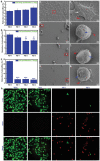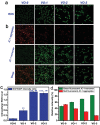Vanadium Dioxide Nanocoating Induces Tumor Cell Death through Mitochondrial Electron Transport Chain Interruption
- PMID: 31565366
- PMCID: PMC6436600
- DOI: 10.1002/gch2.201800058
Vanadium Dioxide Nanocoating Induces Tumor Cell Death through Mitochondrial Electron Transport Chain Interruption
Abstract
A biomaterials surface enabling the induction of tumor cell death is particularly desirable for implantable biomedical devices that directly contact tumor tissues. However, this specific antitumor feature is rarely found. Consequently, an antitumor-cell nanocoating comprised of vanadium dioxide (VO2) prepared by customized reactive magnetron sputtering has been proposed, and its antitumor-growth capability has been demonstrated using human cholangiocarcinoma cells. The results reveal that the VO2 nanocoating is able to interrupt the mitochondrial electron transport chain and then elevate the intracellular reactive oxygen species levels, leading to the collapse of the mitochondrial membrane potential and the destruction of cell redox homeostasis. Indeed, this chain reaction can effectively trigger oxidative damage in the cholangiocarcinoma cells. Additionally, this study has provided new insights into designing a tumor-cell-inhibited biomaterial surface, which is modulated by the mechanism of mitochondria-targeting tumor cell death.
Keywords: anticancer; charge transfer; functional coatings and films; mitochondria; vanadium dioxide.
© 2018 The Authors. Published by WILEY‐VCH Verlag GmbH & Co. KGaA, Weinheim.
Conflict of interest statement
The authors declare no conflict of interest.
Figures







Similar articles
-
A functionalized surface modification with vanadium nanoparticles of various valences against implant-associated bloodstream infection.Int J Nanomedicine. 2017 Apr 18;12:3121-3136. doi: 10.2147/IJN.S129459. eCollection 2017. Int J Nanomedicine. 2017. PMID: 28458535 Free PMC article.
-
Nano vanadium dioxide films deposited on biomedical titanium: a novel approach for simultaneously enhanced osteogenic and antibacterial effects.Artif Cells Nanomed Biotechnol. 2018;46(sup2):58-74. doi: 10.1080/21691401.2018.1452020. Epub 2018 Mar 21. Artif Cells Nanomed Biotechnol. 2018. PMID: 29560740
-
Cytotoxicity of vanadium oxide nanoparticles and titanium dioxide-coated vanadium oxide nanoparticles to human lung cells.J Appl Toxicol. 2020 May;40(5):567-577. doi: 10.1002/jat.3926. Epub 2019 Dec 23. J Appl Toxicol. 2020. PMID: 31869448
-
Milestones and recent discoveries on cell death mediated by mitochondria and their interactions with biologically active amines.Amino Acids. 2016 Oct;48(10):2313-26. doi: 10.1007/s00726-016-2323-z. Epub 2016 Sep 12. Amino Acids. 2016. PMID: 27619911 Review.
-
Reactive Oxygen Species and the Aging Eye: Specific Role of Metabolically Active Mitochondria in Maintaining Lens Function and in the Initiation of the Oxidation-Induced Maturity Onset Cataract--A Novel Platform of Mitochondria-Targeted Antioxidants With Broad Therapeutic Potential for Redox Regulation and Detoxification of Oxidants in Eye Diseases.Am J Ther. 2016 Jan-Feb;23(1):e98-117. doi: 10.1097/MJT.0b013e3181ea31ff. Am J Ther. 2016. PMID: 21048433 Review.
Cited by
-
Photocatalytic Activity of Ti-SBA-15/C3N4 for Degradation of 2,4-Dichlorophenoxyacetic Acid in Water under Visible Light.J Anal Methods Chem. 2022 Mar 22;2022:5531219. doi: 10.1155/2022/5531219. eCollection 2022. J Anal Methods Chem. 2022. PMID: 35360448 Free PMC article.
-
The Interplay between Endogenous and Foodborne Pro-Oxidants and Antioxidants in Shaping Redox Homeostasis.Int J Mol Sci. 2024 Jul 17;25(14):7827. doi: 10.3390/ijms25147827. Int J Mol Sci. 2024. PMID: 39063068 Free PMC article. Review.
-
Investigation of toxicity effect of TiCN coated on 304 SS and 410 SS substrates in rat fibroblasts and B-lymphocytes.Toxicol Res (Camb). 2022 Mar 16;11(2):286-298. doi: 10.1093/toxres/tfac007. eCollection 2022 Apr. Toxicol Res (Camb). 2022. PMID: 35510235 Free PMC article.
-
Molecular and Cellular Mechanisms of Cytotoxic Activity of Vanadium Compounds against Cancer Cells.Molecules. 2020 Apr 10;25(7):1757. doi: 10.3390/molecules25071757. Molecules. 2020. PMID: 32290299 Free PMC article. Review.
-
Visible Light-Driven Phenol Degradation via Advanced Oxidation Processes with Ferrous Oxalate Obtained from Black Sands: A Kinetics Study.Molecules. 2025 May 6;30(9):2059. doi: 10.3390/molecules30092059. Molecules. 2025. PMID: 40363864 Free PMC article.
References
-
- a) Hanker J., Giammara B., Science 1988, 242, 885; - PubMed
- b) Tang R., Moyano D. F., Subramani C., Yan B., Jeoung E., Tonga G. Y., Duncan B., Yeh Y.‐C., Jiang Z., Kim C., Rotello V. M., Adv. Mater. 2014, 26, 3310; - PMC - PubMed
- c) Bowen P. K., Drelich J., Goldman J., Adv. Mater. 2013, 25, 2577; - PubMed
- d) Wang H., Kwok D. T. K., Xu M., Shi H., Wu Z., Zhang W., Chu P. K., Adv. Mater. 2012, 24, 3315; - PubMed
- e) Banerjee I., Pangule R. C., Kane R. S., Adv. Mater. 2011, 23, 690; - PubMed
- f) Hu Y., Cai K. Y., Luo Z., Jandt K. D., Adv. Mater. 2010, 22, 4146. - PubMed
-
- a) Ma H., Luo J., Sun Z., Xia L., Shi M., Liu M., Chang J., Wu C., Biomaterials 2016, 111, 138; - PubMed
- b) Zhang M., Cheng H., Gong Z., Zhang J., Liu X., Wang B., Ban L., Zeng Y., Zhu Z., Adv. Funct. Mater. 2017, 27, 1703932.
-
- a) Ma H., Jiang C., Zhai D., Luo Y., Chen Y., Lv F., Yi Z., Deng Y., Wang J., Chang J., Wu C., Adv. Funct. Mater. 2016, 26, 1197;
- b) Wang X., Li T., Ma H., Zhai D., Jiang C., Chang J., Wang J., Wu C., NPG Asia Mater. 2017, 9, e376.
LinkOut - more resources
Full Text Sources

